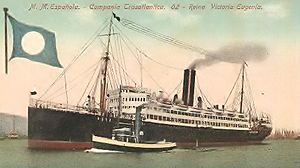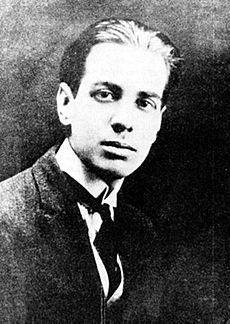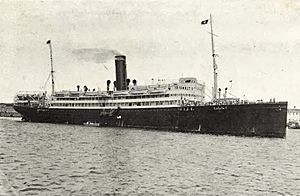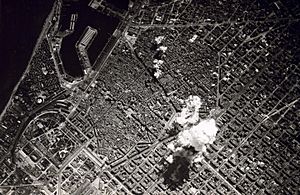SS Reina Victoria-Eugenia facts for kids
class="infobox " style="float: right; clear: right; width: 315px; border-spacing: 2px; text-align: left; font-size: 90%;"
| colspan="2" style="text-align: center; font-size: 90%; line-height: 1.5em;" | 
|} The SS Reina Victoria-Eugenia was a large steamship built in England in 1912. She was an ocean liner, which means she carried passengers across the ocean, and also a mail ship. Her owner was a Spanish company called Compañía Transatlántica Española (CTE).
This ship and her sister ship, the Infanta Isabel de Borbon, were very important. They helped CTE update its fleet of older ships.
In 1931, after Spain became a republic, Reina Victoria-Eugenia was renamed Argentina. She was taken out of service in 1932.
During the Spanish Civil War in 1939, an air attack by Nationalist forces sank Argentina in the Port of Barcelona. Her wreck was later pulled up in 1940 and taken apart for scrap metal in 1945.
Contents
| History | |
|---|---|
| Name |
|
| Namesake |
|
| Owner | Compañía Transatlántica Española |
| Operator | |
| Port of registry | Barcelona |
| Route | Barcelona – Buenos Aires |
| Builder | Swan, Hunter & Wigham Richardson, Low Walker |
| Yard number | 884 |
| Launched | 26 September 1912 |
| Completed | February 1913 |
| Maiden voyage | 12 March 1913 |
| Identification | |
| Fate | Sunk by air attack, raised, scrapped |
| General characteristics | |
| Type | ocean liner |
| Tonnage |
|
| Length | 480.0 ft (146.3 m) |
| Beam | 61.3 ft (18.7 m) |
| Draught | 25.0 ft (7.6 m) |
| Depth | 32.7 ft (10.0 m) |
| Decks | 3 |
| Installed power | 1,484 NHP |
| Propulsion |
|
| Speed |
|
| Capacity |
|
| Crew | 250 |
| Sensors and processing systems |
|
| Armament | passive provision for four naval guns |
| Notes |
|
Building the Ship
Swan, Hunter & Wigham Richardson built Reina Victoria-Eugenia at their Neptune Yard in Low Walker, England. She was launched into the water on September 26, 1912, and finished being built in February 1913.
At the same time, another company, William Denny and Brothers, built her sister ship, Infanta Isabel de Borbon. Even though they were sister ships, they had some important technical differences.
Engine Design and Innovation
A few years before, in 1908, Denny's had built a ship called Otaki. This ship was special because it was the first in the world to use a mix of reciprocating steam engines and steam turbines for power. The Otaki had three propellers. Two of them were powered by traditional steam engines, and the steam from these engines then went to a turbine that powered the third, middle propeller. This made the ship more efficient.
Other famous ships, like the White Star Line's Laurentic and the huge Olympic-class ocean liners (which included the Titanic), also used this mix of engines. CTE wanted a similar engine setup for Infanta Isabel de Borbon and Reina Victoria-Eugenia. Denny's gave Infanta Isabel de Borbon the same three-propeller system as Otaki.
However, Swan, Hunter, the builders of Reina Victoria-Eugenia, had been experimenting. They preferred a four-propeller system. In their design, the traditional steam engines powered the two middle propellers, and the steam turbines powered the two outer propellers. This idea had been used successfully on a French liner called Rochambeau. CTE agreed to this new setup for Reina Victoria-Eugenia.
Ship Features
The two sister ships looked a little different. Reina Victoria-Eugenia had a taller smokestack (funnel).
Reina Victoria-Eugenia was equipped with wireless telegraphy, which allowed her to send and receive messages by radio. She also had submarine signalling, a way to communicate underwater. By 1914, her special radio code was EDU.
Swan, Hunter designed Reina Victoria-Eugenia to carry many passengers, with space for 2,066 people in total. This included different classes: 200 first-class, 46 "interchangeable" class, 100 second class, 80 third class, and 1,640 in third and emigrant classes. Her fancy public rooms were decorated in historical styles, like Louis XVI and Neo-Georgian.
The ship was also built so that it could be easily changed into an armed merchant cruiser if needed. This meant it had places where four naval guns could be added.
Reina Victoria-Eugenia was officially registered in Barcelona, Spain. Her original code letters were JFGW.
Ship Performance
Reina Victoria-Eugenia had her sea trials in February 1913. These tests happened in the North Sea near the River Tyne. Her builders had promised she would be able to travel at certain speeds.
The ship was required to go 17.5 knots (32.4 km/h) for eight hours when half-loaded. She also needed to go 16 knots (30 km/h) for 24 hours when fully loaded. During her trials, even in bad weather, she averaged 18.12 knots (33.56 km/h) when half-loaded. When fully loaded, she averaged 16.10 knots (29.82 km/h).
Her fastest speed during trials was 18.6 knots (34.4 km/h). This was measured over a special "measured mile" course. People said that once the ship reached Spain, she went even faster in the deeper waters off Cádiz.
Ship Service
CTE's ships connected Italy and Spain with countries in Latin America. On March 12, 1913, Reina Victoria-Eugenia began her first journey. She sailed from Barcelona, stopping at Malaga, Cádiz, Tenerife, and Montevideo, before arriving in Buenos Aires. Her sister ship, Infanta Isabel de Borbon, started her first voyage soon after.
During the First World War, both Infanta Isabel de Borbon and Reina Victoria-Eugenia sometimes sailed to New York. However, their main route remained between Spain and the Río de la Plata region.
Wartime Incident
In May 1918, during World War I, Reina Victoria-Eugenia was sailing from Tenerife to Spain. The Royal Navy (British navy) made her change course and go to Gibraltar. This was because the British thought there might be German men of military age on board.
Authorities in Gibraltar found a German sailor who had been held on the Canary Islands since his ship was sunk in 1914. He was traveling with a Spanish armed guard. There was also a German professor on board. The British allowed the German sailor to continue his journey once they were sure he was under guard. The British government asked Spain to tell them about future transfers of enemy citizens by sea, to avoid any problems.

After the war, both ships went back to their regular routes between Spain and the Río de la Plata. For a while, they also stopped at Almería and Rio de Janeiro. The famous Argentinian writer Jorge Luis Borges traveled on Reina Victoria-Eugenia in 1922.
These two ships were CTE's most important passenger liners. Later, new, slightly larger ships like Alfonso XIII and Cristóbal Colón were built in 1923, and then Juan Sebastian Elcano and Marques de Comillas in 1928.
By 1926, Reina Victoria-Eugenia had new equipment for wireless direction finding. This helped her figure out her position using radio signals. In 1931, after the Second Spanish Republic was formed, CTE changed the names of its ships that were named after members of the Spanish royal family. So, Infanta Isabel de Borbon became Uruguay, and Reina Victoria-Eugenia became Argentina.
Ship's Final Years
The Spanish government used to pay CTE to provide mail service between Spain, Uruguay, and Argentina. In 1932, the new government stopped this payment. Because of this, CTE ended the service on May 8 and took Argentina and Uruguay out of service, keeping them docked in Barcelona.
By 1934, Argentina's old radio codes were replaced with a new four-letter call sign: EAIE.
Argentina and Uruguay were still in Barcelona when the Spanish Civil War started in 1936. In January 1939, Nationalist forces were getting close to Barcelona and their air force bombed the city. Air raids damaged Argentina starting on January 16, and both ships were hit on January 23. Both ships sank where they were docked.
Barcelona fell to the Nationalists on January 26, and the Second Republic ended on April 1. By 1940, the Nationalists had pulled up Argentina's sunken ship. She was then taken to Bilbao and completely scrapped (taken apart for materials) in 1945.
See also
 In Spanish: Reina Victoria Eugenia (1913) para niños
In Spanish: Reina Victoria Eugenia (1913) para niños



